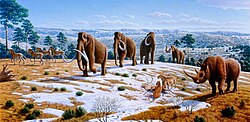Woolly mammoth
The woolly mammoth (Mammuthus primigenius) is an extinct species of mammoth from the Pleistocene period until its death in the Holocene epoch. They were large elephants which lived during the ice ages. The animal is known from bones and frozen carcasses from northern North America and northern Eurasia. The best-preserved carcasses (including Yuka) were found in Siberia. These mammoths are perhaps the most well known and most iconic species of mammoth. Woolly mammoths are now extinct, so we can't see them anymore. This mammoth species was first recorded in deposits of a former glaciation in Eurasia, perhaps 150,000 years ago.[1][2] Their closest living relatives are Asian elephants.
| Woolly mammoths Temporal range: Pleistocene – Holocene
| |
|---|---|

| |
| Woolly mammoths | |
| Scientific classification | |
| Domain: | |
| Kingdom: | |
| Phylum: | |
| Class: | |
| Order: | |
| Family: | |
| Genus: | |
| Species: | †M. primigenius
|
| Binomial name | |
| Mammuthus primigenius (Blumenbach, 1799)
| |

Woolly mammoths coexisted with early humans, who hunted them, and their bones and tusks were used as tools, and dwellings. Mammoths were also hunted for food. The species disappeared from most of its range at the end of the Pleistocene (10,000 years ago), with a dwarfed race and small populations still living on Wrangel Island until about 1700 BC.[3]
Cave paintings of the woolly mammoth have been found in caves in France and Spain.
Description
Height
Male mammoths can reach between 2.67 and 3.49 m (8 ft 9 in and 11 ft 5 in) and weigh between 3.9 and 8.2 t (3.8 and 8.1 long tons; 4.3 and 9.0 short tons). Females can reach 2.3–2.6 m (7 ft 7 in – 8 ft 6 in) in shoulder heights and weigh between 2.8–4 t (2.8–3.9 long tons; 3.1–4.4 short tons). A calf weighs about 90 kg (200 lb).
Coat
A woolly mammoth's coat could easily adapt to the chilly conditions during glacial periods. This coat was covered with thick fur to keep themselves warm in the cold weather.
Resurrection
Scientists are currently working to resurrect this mammoth. In 2003, the Pyrenean ibex (also called a bucardo) was temporarily resurrected, and the clone died several minutes after birth due to a lung defect,[4] so this could mean woolly mammoths would be revived soon.
Notable specimens
Yuka the mammoth
Yuka is a preserved woolly mammoth discovered by local Siberian tusk hunters in August 2010 and also had a broken hind leg, which likely occurred as it tried to escape and fell.[5]
Lyuba the mammoth
Lyuba is another well-known mammoth. She was formerly the best preserved mammoth mummy in the world (now held by Yuka).
Yukagir Mammoth
The Yukagir Mammoth is a frozen adult male woolly mammoth discovered in 2002 in northern Yakutia and is considered a exceptional discovery.[6] The specimen is named after the Siberian village of Yukagir near where it was found.[7]
In popular culture
Woolly mammoths are popular creatures nowadays, appearing in many media, including movies. One notable example is the 2002 movie Ice Age, in which there is a mammoth named Manny, who is a major character.
Woolly Mammoth Media
Georges Cuvier's 1796 comparison between the mandible of a woolly mammoth (bottom left and top right) and an Indian elephant (top left and bottom right)
Comparison between the lower molars of a woolly mammoth (above) and a southern mammoth; note the lower number of enamel ridges in the older species (below)
Phylogeny of mammoths, showing the relationship between the Columbian mammoth and woolly mammoth, as well as early steppe mammoth-like Siberian mammoths, demonstrating significant introgressive gene flow from the woolly mammoth into the Columbian mammoth
Model at the Royal BC Museum
Molar from Font de Champdamoy, France, Musée Georges-Garret
Life restoration of fauna during the Pleistocene epoch in northern Spain, by Mauricio Antón, 2004
Related pages
- Mastodon – a distantly related taxon to mammoths
- Steppe mammoth
- Mammuthus meridionalis
- Columbian mammoth
References
- ↑ "Yukon Beringia Interpretive Centre - Woolly Mammoth". www.beringia.com. Archived from the original on 2009-04-03. Retrieved 2009-03-26.
- ↑ Lister A.M.; Sher A.V.; Van Essen H.; Wei G. 2005. The pattern and process of mammoth evolution in Eurasia. Quaternary International. 126–128: 49–64. [1]
- ↑ Nowak, Ronald M. (1999). Walker's Mammals of the World. Baltimore: Johns Hopkins University Press. ISBN 0801857899.
- ↑ "First birth of an animal from an extinct subspecies (Capra pyrenaica pyrenaica) by cloning". Theriogenology.
- ↑ Yirka, Bob (5 April 2012). "Well preserved mammoth from Siberia shows signs of early man stealing from lions". Phys.org.
- ↑ "The Yukagir Mammoth: Brief History, 14c dates, individual age, gender, size, physical and environmental conditions and storage" (PDF). Scientific Annals, School of Geology Aristotle University of Thessaloniki. Archived from the original (PDF) on 2023-08-20. Retrieved 2025-05-21.
- ↑ ""NOVA | scienceNOW | A Mammoth Waste of Time image 2 | PBS". www.pbs.org. Archived from the original on 2017-07-14. Retrieved 2025-05-21.
Other websites
![]() Media related to Woolly mammoth at Wikimedia Commons
Media related to Woolly mammoth at Wikimedia Commons
- Natural History Museum: "The last of the mammoths" – three-minute video about the extinction of the woolly mammoth, presented by Adrian Lister
- National Geographic: "Mammoth tusk treasure hunt" – two-minute video about mammoth tusk collecting in modern Siberia











